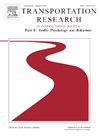周边车辆速度变化对新手驾驶员眼动、主观认知及驾驶行为的影响
IF 4.4
2区 工程技术
Q1 PSYCHOLOGY, APPLIED
Transportation Research Part F-Traffic Psychology and Behaviour
Pub Date : 2025-06-12
DOI:10.1016/j.trf.2025.06.009
引用次数: 0
摘要
崩溃通常是由于周围交通的动态变化,需要复杂的信息处理。虽然之前的研究主要集中在有经验的司机身上,但新手司机更容易分心,他们的视觉搜索范围更窄,反应也更慢。本研究利用驾驶模拟平台和眼动仪,对29名参与者在动态多车环境下的新手驾驶员的感知、认知和操作进行了研究。结果表明:(1)新手驾驶员注视次数越多、注视时间越长、速度认知越准确、风险评价越高、变道等转向行为越多;(2)他们对前车的速度变化比后车更敏感,这可能是由于前车在中央凹视野范围内。在减速场景下,新手驾驶员表现出比加速场景更警觉的眼动、更准确的速度认知、更频繁的风险评估和更多的转向行为。(3)男性驾驶员的速度认知、风险评估和危险行为均低于女性驾驶员。本文章由计算机程序翻译,如有差异,请以英文原文为准。
Impact of velocity changes of surrounding vehicles on the eye movement, subjective cognition, and driving behaviour of novice drivers
Crashes often arise from dynamic changes in surrounding traffic that require complex information processing. While previous studies have focused on experienced drivers, novice drivers are more prone to distraction, with narrower visual search and slower reactions. This study explores the perception, cognition, and operation of novice drivers in dynamic multi-vehicle environments, using a driving simulation platform and eye tracker with 29 participants. Three key findings emerged: (1) Novice drivers showed positive correlations between higher fixation numbers, longer fixation durations, more accurate velocity cognition, higher risk assessment, and more steering behaviours like lane changes. (2) They were more sensitive to the velocity changes of leading vehicles than behind vehicles, likely due to the leading vehicle being in foveal vision. In deceleration scenarios, novice drivers exhibited more alert eye movements, more accurate velocity cognition, more frequent risk assessments, and more steering behaviours than in acceleration scenarios. (3) Male drivers showed less accurate velocity cognition, lower risk assessment, and more dangerous behaviours than females.
求助全文
通过发布文献求助,成功后即可免费获取论文全文。
去求助
来源期刊
CiteScore
7.60
自引率
14.60%
发文量
239
审稿时长
71 days
期刊介绍:
Transportation Research Part F: Traffic Psychology and Behaviour focuses on the behavioural and psychological aspects of traffic and transport. The aim of the journal is to enhance theory development, improve the quality of empirical studies and to stimulate the application of research findings in practice. TRF provides a focus and a means of communication for the considerable amount of research activities that are now being carried out in this field. The journal provides a forum for transportation researchers, psychologists, ergonomists, engineers and policy-makers with an interest in traffic and transport psychology.

 求助内容:
求助内容: 应助结果提醒方式:
应助结果提醒方式:


